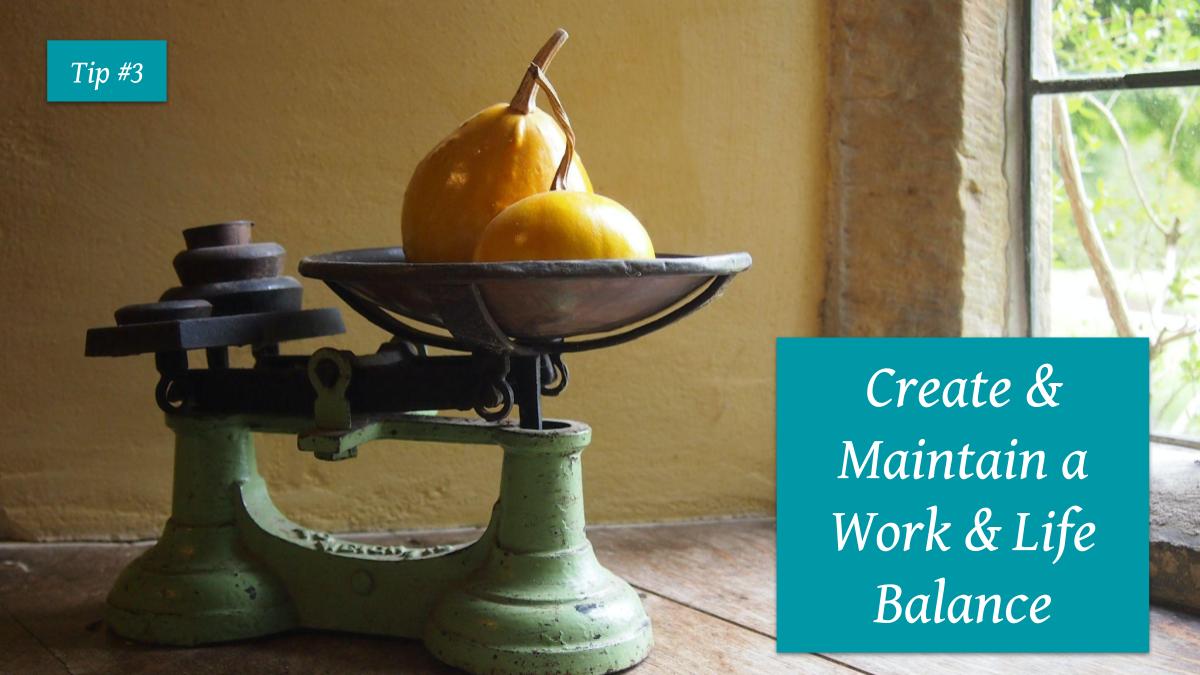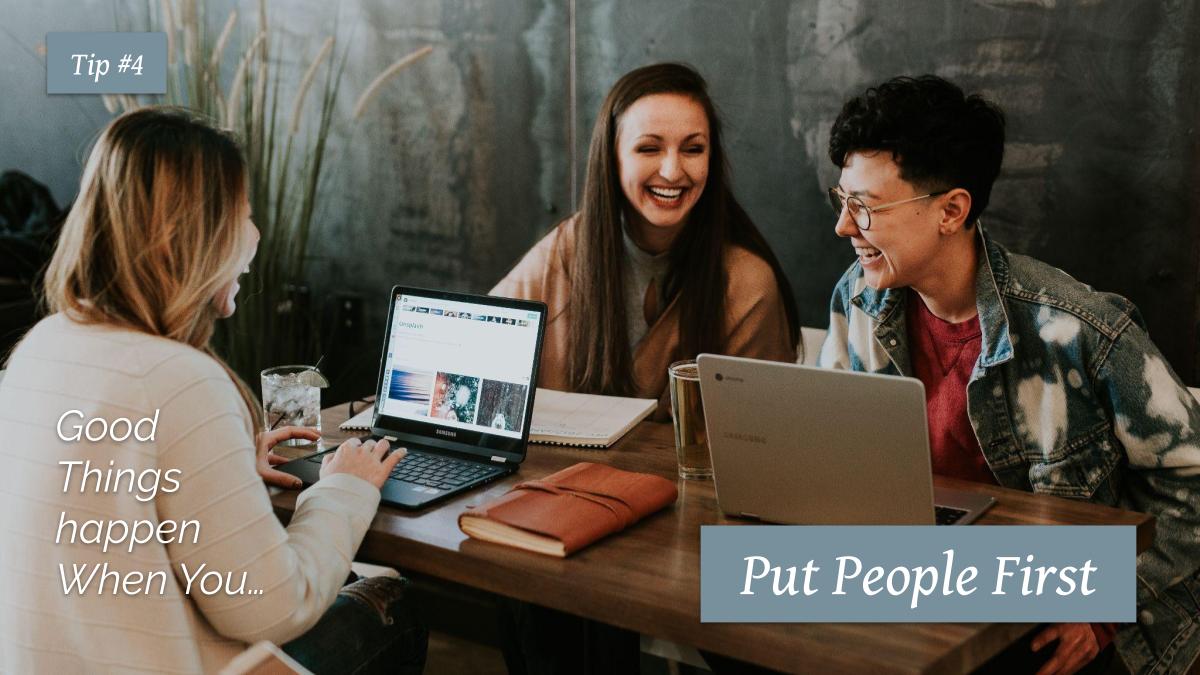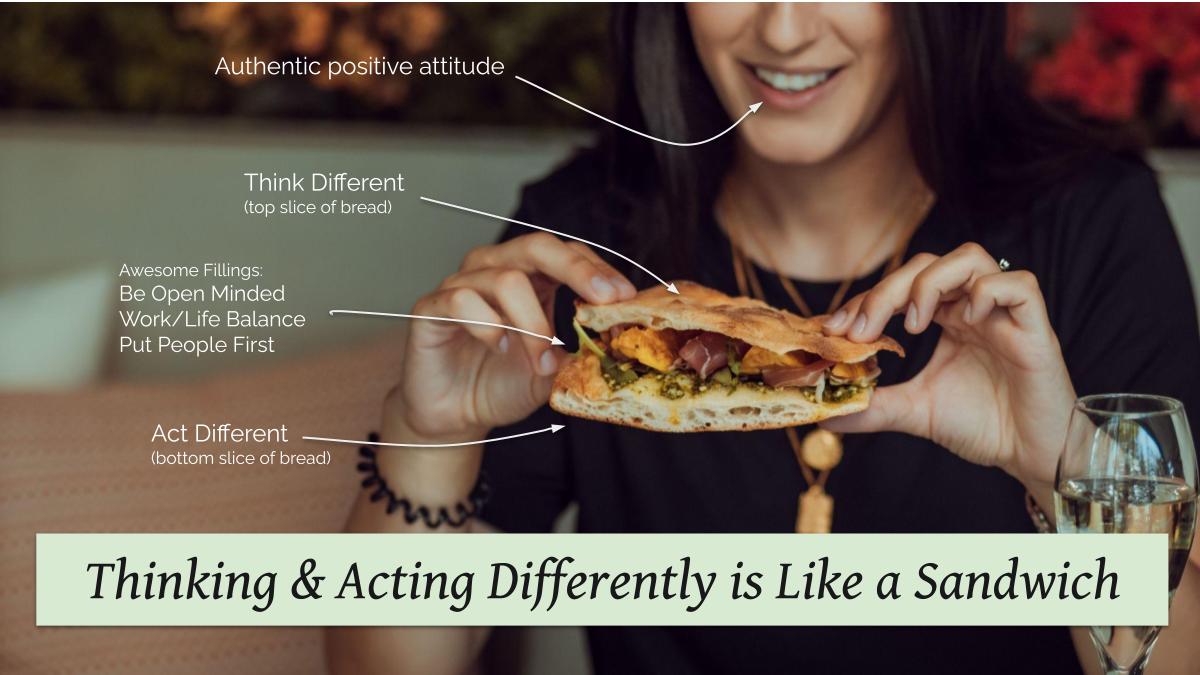The first step to solving problems is to think and act differently than before.
It can be a small action, like moving your to-do list to an app in place of your sticky notes that no longer stick and get lost. Or it could be significant, like changing jobs or careers. Either way, and for every scenario in-between, when you think and act differently, you enable success and disrupt failing patterns.
This article shares four actionable tips to help you think and act differently and set you on the path to success. Ready to stop making the same mistakes and take a different perspective?
Table of Contents
- [Tip #1] Take a Different Perspective
- [Tip #2] Be Open Minded
- [Tip #3] Create and Maintain a Work/Life Balance
- [Tip #4] Good Things Happen When You Put People First
- Why We Should Think and Act Differently
- Bonus Question: What If Thinking & Acting Differently Feels Impossible to Do?
- Recap: Think and Act Differently is Like a Delicious Sandwich
[Tip #1] Take a Different Perspective

“The definition of insanity is doing the same thing over and over and expecting different results.” Although this quote is often mis-attributed to Albert Einstein(2) it describes his approach to conceptual thinking and his world changing discoveries that followed.
In their famous Think different video, Apple Inc. highlights “the crazy ones, the troublemakers, the round pegs in the square holes…” who share the same trait of positive disruption that Einstein so excelled at. The video opens with Einstein turning towards the camera and closes with the motivational call to action, “… because the people who are crazy enough to think they can change the world are the ones that do.”
So how do you change the world? Can you change the world, even?
Isn’t it awfully big?
To me, the world is massive(3), almost too big to comprehend. Rather than ruminate on how to change the world with its billions of citizens, problems, and products, I focus on the micro over the macro.
In place of the larger world, I look at my smaller world. Family, clients, deadlines, researching ways to reduce the amount of garbage I generate, and making time to walk my dogs. Much more manageable.
Your world could be the project you’re working on, the customers you service, and your sphere of influence.
So, yes, you can change the world. Your world. It just takes a different perspective.
Think differently = Take a different perspective.
How Do You Change Your Perspective?

What if your current mouse clicks, responses, and expected viewpoints are so ingrained they’re part of your muscle memory? How do you disrupt those patterns and take a different perspective?
How do you change?
Well, the clue is in the back half of the question. You change.
Merriam-Webster’s dictionary defines “change” in several ways:
- to give a different position, course, or direction to
- to replace with another
- to undergo transformation, transition, or substitution
Stop the destructive processes and procedures that long ago spawned organizational gridlock, and replace them with ideas and actions that make ideas spread and tasks flow.
Replace old for new. That’s how you change the world. How you solve the problems others can’t.
Act differently = Take action. Stop the old and replace with the new.
Related video
Additional Reading in The Become a Better Problem Solver Series
[Tip #2] Be Open Minded

Having an open mind encourages a growth mindset. When you are open to learning new concepts, you fill your mind with fresh ideas you can put into practice, so when your colleagues, boss, or client asks, “Can you help solve this problem?” you can.
Your deep pool of knowledge gives you a clear perspective on the root cause of the problem and how to produce the solution.
Because you listen and learn and deliver, you have a reputation for being easy to work with and for getting things done. You:
- Are open to learning new things.
- Create solutions others haven’t thought of.
- Reduce friction and frustration at home and at work.
Related video
In the this episode of The Be Helpful Experiment I discuss how being open-minded is more than just listening to new ideas that confirm our bias and offer 3 practical examples.
[Tip #3] Create and Maintain a Work/Life Balance

The phrase work/life balance conjures up an image of a grocer’s scale with a matched number of hours on each plate. In reality, a work/life balance is more a pendulum or wave where your focus shifts between family, friends, and work as needed.
A benefit to being in balance is the positive mindset it creates.
You’re not spending all your time at work feeling guilty about the family moments you’re missing. Nor are you stressing about work while you’re trying to laze away happy hours with parents, partner, or progeny.
Three ways to create and maintain a practical balance between work and life:
- Use your time wisely.
- Help everyone understand why your focus is where it is.
- Be calm when you listen to a diverse range of opinions.
Use Your Time Wisely
Work on the right things at the right time(4). The tasks that are important to your project, the endeavours that are important to your career, the activities that are important to your friends and family. You are not developing repetitive strain injury from endless scrolling through social media, or running yourself ragged doing busy work that benefits no one.
Help Everyone Understand Why Your Focus Is Where It Is
When your family sees the sensible ways you spend your time, they will understand why your focus is where it is.
If the intention for your focus isn’t obvious to those around you, ask yourself these two questions:
- Who am I spending most of my time with?
- Is that short changing anyone?
There’s a finite amount of time available to us, which means as we’re giving to one group of people we’re taking from another.
At work, when I’m spending a lot of time with one team, am I short changing another group or department who needs my help? How does that help them? Is that detrimental to their ability to perform their duties?
On the flip side is the group I’m spending most of my time with thinking, “If Paul just left us alone to do our own thing, we’d be all right.”
Remain Calm When You Listen to a Diverse Range of Opinions
The more information and feedback we receive, the more likely we are to understand the problems people face. Which means we can provide the solution that actually solves their problems.
How do we listen to opinions that differ from our own? We listen without reacting.
Stay calm and take on board what you’re hearing. This prevents the mental leap from erroneous assumption to ruinous conclusion. This helps you think about the message—the spoken words and the ones left out—and understand their meaning. You can find the great idea, the golden nugget, amongst the sand and rocks of the message that might rub you raw.
Related video
I share several relatable examples for a work/life balance and statistics from two major surveys that highlight how we typically spend our days.
[Tip #4] Good Things Happen When You Put People First

Look Out for Each Other
I’ve found life is far more enjoyable when we look out for each other and experience life together. Not strive for success by standing on everyone or putting each other down. Thankfully, looking out for each other is a common trait in 99% of the people I’ve worked with, for, and met.
When we treat people with respect and encourage them to succeed, it not only helps them—because we’ve helped solve whatever problem they are facing—but it also helps us.
For example, helping others through stressful situations helps improve our emotional regulation skills which benefits our overall wellbeing and reduces our own feelings of stress(5).
People First is treating others the way you want to be treated.
Respect People’s Time
Who enjoys filling out endless forms, waiting on hold for hours, or having to repeat oneself because the person “helping” us isn’t listening and keeps giving the wrong information?
And who among us has sighed with relief and gratitude after a short and productive meeting, or for the simple and efficient process we have just encountered, or for our colleagues who follow through on their promises?
Putting people first at work is respecting both them as a person and their time.
Here are some examples:
- Your requests for help are not last minute, the world’s on fire, there will be mass panic if this isn’t done RIGHT NOW!
- Your meetings are to the point, and it’s clear why the meeting was called and what the action items are.
- The processes you ask others to follow are obvious, efficient, and deliver the expected results.
- When people work with you, they know you are listening to them and taking action. The information they provide doesn’t disappear into a bureaucratic maze of forms, spreadsheets, and surveys.
When work is enjoyable and frustration free, even if individual days can be maddening, we’re improving our satisfaction with the work we do and achieving the targets and goals set for us.
Which reduces stress and raises satisfaction and engagement with the work we’re doing and the people we work with.
The outcome of a People First approach is your colleagues, clients, and team want to work with you, to do what you asked them to do.
Not because they have no choice, but because they trust you.
Related video
I share personal insights and experiences to show you can succeed in business and life when you put people first.
Why We Should Think and Act Differently
There are many personal reasons to think in new ways and change our behaviours. We may want to break bad habits, to become more spontaneous, mindful, kind, or generous.
In business, the ability to think and act differently ignites innovation, sparks growth, and fires-up success. Examples include the iPhone, cloud computing and software-as-a-service, and ride-sharing services such as Uber.
When we don’t innovate, when we remain stagnant in our thinking and actions, we perpetuate the problems that generate waste and cause us to quit our jobs in frustration.
This set in stone thinking, destined to repeat the same mistakes from before, helps explain why 60% of projects don’t deliver their promises, why almost 10% of money invested in a project is wasted, and why 53% of us are not cognitively and emotionally connected to our work and workplace(1).
Imagine going to a petrol station to fill your car and pouring one gallon of fuel—that you’ve already paid for—across the garage forecourt. Every trip.
That is how it feels when we don’t think and act differently. When we repeat the same mistakes over and over and expect different results.
Bonus Question: What If Thinking & Acting Differently Feels Impossible to Do?

It begins with a positive attitude, one that is authentic to you. Not fake smiles and cheap platitudes borrowed from a celluloid depiction of the suburban dream with white picket fences and the perfect family.
Your style of positivity is likely different to mine and is distinct from your colleagues and clients. And that’s perfect.
The goal is to be personable, to be proud of the work you do, to see growth in adversity, rather than disaster and calamity.
Why Do You Need a Positive Attitude?
Scientific research suggests a positive attitude(6) benefits physical health while stress closes down the networks in the brain associated with self-control and making sound decisions.
Authentic positivity is a boon to building trust and increasing resilience from stress and burnout. It helps me through the days when the coffee pot is empty or I need to take a walk before responding to the angry email bullying my inbox and demanding my attention.
4 Ways to Build a Sustainable Positive Attitude
Like everything in life, there’s a balance. A bit of happy, a bit of sad, a bit of good, a bit of bad. The following behaviours help make thinking and acting differently a sustainable and healthy habit:
- Take a different perspective.
- Be open-minded.
- Maintain a work/life balance.
- Put people first.
Recap: Think and Act Differently is Like a Delicious Sandwich

Think Differently and Act Differently is the bread that holds the sandwich together. A perfect slice on either side. You need both. You can’t have a hunger busting, awesome sandwich with only one slice of bread. There would be nothing to hold the filling.
The filling and the flavors that bring it all together are:
- Be open minded: you’re open to new ideas and consider solutions others haven’t thought of.
- Maintain a balance between work and life: You use your time wisely, everyone understands why your focus is where it is, and you listen to a diverse range of opinions.
- Good things happen when you put people first: You treat others the way you want to be treated.
The moment you take a bite of your fresh, favourite sandwich(7), it’s guaranteed to:
- put a smile on your face
- put you in a good mood
- enable you to take a different perspective on the problems around you and to find the right solutions
Ready to take a bite of the think and act differently sandwich? Yum!
Additional Reading
This is the first article in a four-part series on how to solve business problems.
Think & Act Differently shares strategies for how to take a different perspective when solving problems.
Ethical Leadership highlights ways to build trust with your colleagues and clients so they believe in your solutions.
Ask the Right Questions introduces two powerful questions that get to the root of the problem and help you define the right solution.
The final article, Develop The Be Helpful Keystone Habit, takes the strategies highlighted in the previous articles and turns them into a powerful and lasting habit.
Footnotes
- Project Management and Employee Engagement survey results come from: Wellingtone PPM Intelligence’s The State of Project Management 2018 survey, Project Management Institute’s Pulse of the Profession 2018 report, and Gallup’s State of the American Workplace 2017 survey. ↪︎ return
- The quote is often attributed to Einstein though it is generally accepted he didn’t say it. The evidence points instead to several sources, including a Narcotics Anonymous pamphlet printed in 1981. ↪︎ return
- As oblate spheroids go, Earth is a damn good size with a circumference of 40,000 km, covered in 70% water and 7.7 billion people. Generating protective magnetic rays, like a hot Swedish meatball comforts a nervous male within a labyrinthine IKEA store, is a molten core of iron sloshing around at 5,200 degrees celsius. ↪︎ return
- If you feel most of your work day is spent reading and answering emails or shaking your head at your inbox, you’re right. A McKinsey Company report on how we spend our time at work found that 28% of our working hours is taken up by email. That’s a lot considering we also have meetings to attend, info we need to gather from others, and do the work we’ve been assigned. Episode 1 of The Be Helpful Experiment shares more info on the survey results. ↪︎ return
- Feeling better about ourselves because we’ve helped others isn’t just anecdotal or a catch phrase. Here are two articles that explain some of the science as to why helping others makes us feel better: The benefits of social regulation of emotion and helping others lowers your stress and anxiety levels. ↪︎ return
- The science behind how a positive attitude helps you physically and how stress impacts our decisions and habits. ↪︎ return
- Pragmatic definition: Deal with things sensibly and realistically.
Dogmatic definition: Follow a set of rules, no matter what.
↪︎ return
- Oh, the sandwich! That most glorious of epicurean delights. I could eat a cheese sandwich for lunch everyday – I am but a man of simple pleasures. As a 12 year old, the best part of the school day was when the canteen opened and we put down £1 for that hot, greasy, buttery taste of freedom that would release us from the drudgery of our Dickensian, English classroom – the humble chip butty. ↪︎ return





